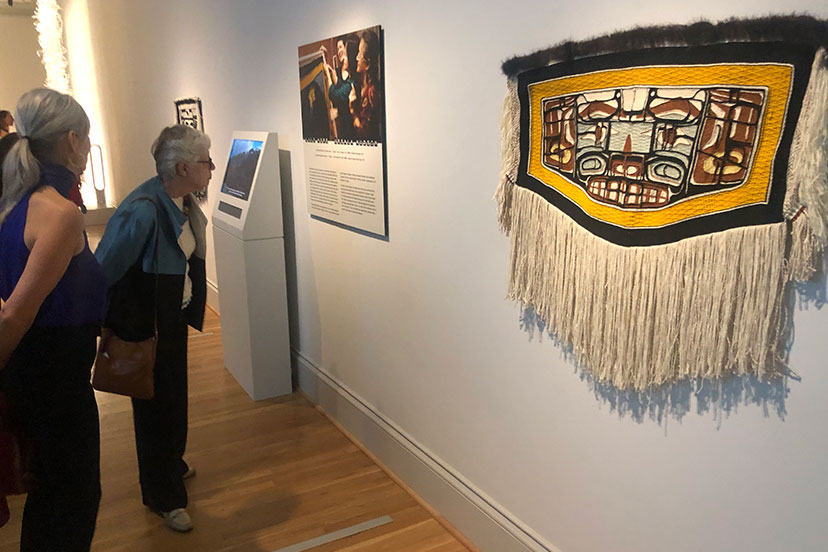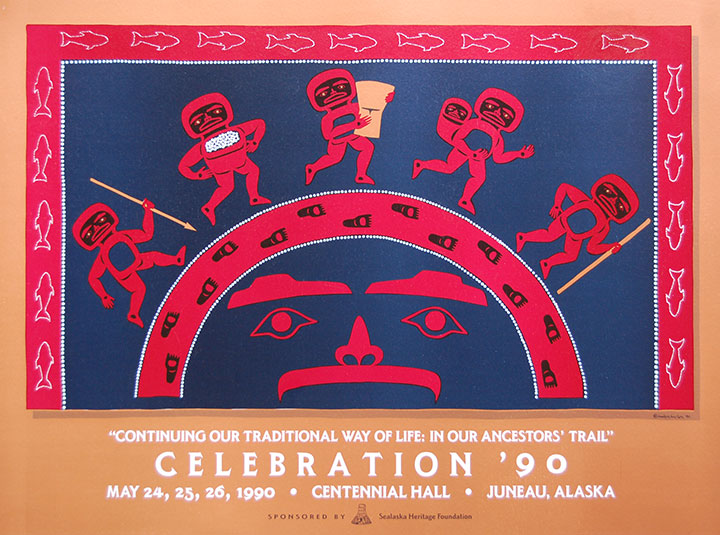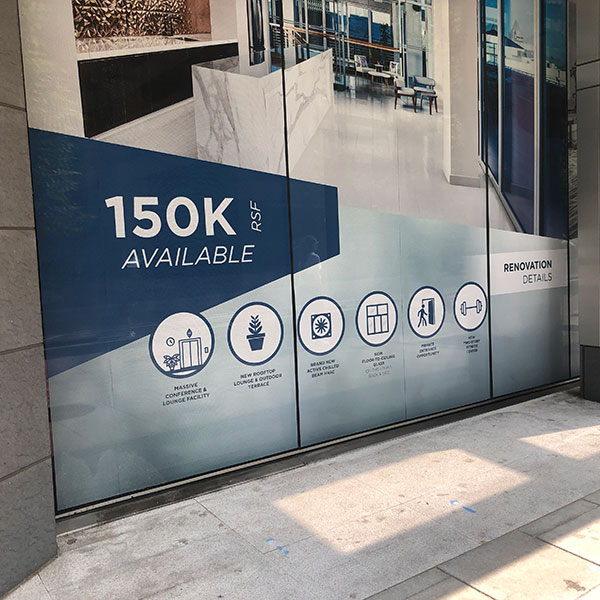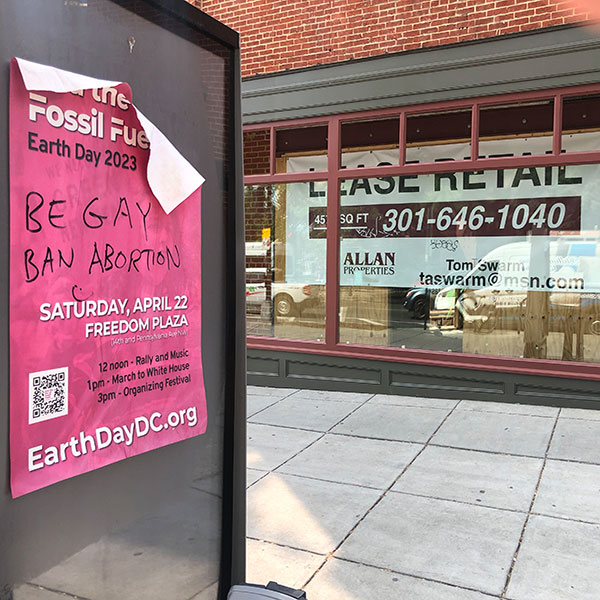I suppose our Daily Post readers can imagine how it felt, to have my two daughters exhibiting their artwork, together, at the Renwick Gallery… one of the more prestigious galleries in the U.S., located a few doors down the street from the White House in Washington DC.
Not that I’m claiming any credit, as their father. I would never do that.
As mentioned before, Chilkat robes are traditionally, among the Indians of the Northwest Coast, ceremonial regalia, worn by individuals of high social status on important occasions. The limited color scheme — black, yellow, white, green, turquoise — reflect the natural dye colors historically available along the Northwest Coast.
Another type of robe — the so-called button blanket robes — became common following the arrival of European traders, who brought commercial wool blankets and mother-of-pearl buttons to trade for animal furs.
Button blankets, decorated with your clan’s totemic animal, are now pretty much a standard item of regalia for anyone participating in a ceremony. Unless you’re fortunate enough to have access to a Chilkat robe.
Traditionally, these ceremonial robes are stored away, out of sight, until an appropriate time comes to wrap them around a celebrated person.
Those of us who are not Tlingit, and who may have a different set of cultural values, will sometimes come across these intricate and valuable robes in a museum or gallery, as happened at the Renwick last month. In that setting, Chiklat weavings are fascinating curiosities; pieces of art… detached, however, from their traditional cultural role.
Back in 1990, my wife Clarissa and I were asked to design a poster for a popular biannual event in Juneau, Alaska — a gathering of the tribes of the Northwest Coast, known simply as “Celebration”…. three days of dancing, singing, speeches, storytelling, and socializing.
Here’s the poster we came up with:
The event organizers explained the theme. “Continuing Our Traditional Way of Life: In Our Ancestors’ Trail”. For the poster design, Clarissa and I chose to portray a ceremonial button blanket. (A few years later, Clarissa produced an actual button blanket using this same design.)
In this design, the “Trail” — marked by the footprints of the Ancestors — follows the arch of the rising Sun; the People following the Trail represent important aspects of traditional Northwest Coast culture: hunting and fishing; berry-gathering; the bearing of ‘wealth’ symbolized by a ‘Tin’naa’ (copper shield); motherhood… and at the far right, an Elder leading the way. Also traveling alongside the People, the Salmon are returning, as they do each summer, to nourish the tribes.
Following the ways of the Ancestors is a cherished tradition among many Indian tribes, and family relationships are likewise very important. One of the time-honored traditions, among the Tlingit upper classes, is the effort to build personal wealth, as measured in the primary item of ‘commercial exchange’: blankets and robes. The more blankets a clan member owned, the higher their social status in the tribe.
But the acquisition of wealth — blankets, tools, storage boxes, canoe paddles, copper shields — had a very important communal value. After amassing a hoard of culturally valuable riches, a wealthy clan leader was expected to host a ‘potlatch’, and publicly give it all away in the form of gifts to members of the ‘opposite clan’.
Only by giving everything away, to others in the community, could an individual be considered truly rich.
How curious to be thinking about these values… in an article about Washington DC, in 2023.
Does our dominant American culture value community relationships, and follow in the trail of our ancestors? Perhaps not in the same sense.
Last month, walking the streets of Washington — one of the nation’s key political/economic/commercial/cultural hubs — I passed several large and small parks dominated by bronze statues of military heroes.
One of the parks was surrounded by a chain-link fence, with access prevented by a locked gate.
I was not able to find out which military hero was being celebrated.
But I assumed (without any real evidence) that maybe the park had previously been occupied by homeless citizens, and the city had finally found it necessary to fence off the entire park and lock the gate.
The homeless would then be required to find other places to erect their nylon tents.
That was my assumption.
Hopefully, these homeless citizens were not military veterans. But they might have been.
Another thing I noticed during my strolls through downtown Washington were the surprising number of commercial and retail spaces available for lease. Maybe 10% of the first-floor commercial spaces? Or more?
I understand that the COVID crisis, and the move to remote work, took a toll on commercial real estate in America’s larger cities.
We might wonder if these empty commercial spaces will eventually become ‘residential’ options for the many citizens who have been displaced by skyrocketing home prices and rental rates.
Following the public opening of the Renwick exhibit on Friday — where Lily and Ursala and the other four American Native artists in the show, chatted with gallery visitors about their work and about their cultural heritage — we had a half day to kill before heading to the Ronald Reagan National Airport for the flights back home.
Ursala, Amelie and me, back to Pagosa Springs via Denver and Durango.
Lily and her family, back to Juneau, Alaska.
My son Kahlil and his daughter Violet, back to Santa Fe.
But first, everyone wanted to visit the Smithsonian’s Museum of African American Art, which, as it turned out, was connected to the Museum of Asian American Art. Two more vast collections of cultural items… disconnected from their traditional values.
Not nearly enough time to see everything. But isn’t that the way of things?
Then it was time for a family photo, in front of Lily’s hotel.










